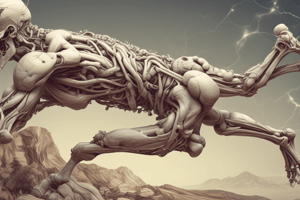Podcast
Questions and Answers
What is the scientific discipline that investigates the body's structure?
What is the scientific discipline that investigates the body's structure?
Anatomy
What scientific investigation examines the processes or functions of living things?
What scientific investigation examines the processes or functions of living things?
Physiology
Which of the following are types of anatomy?
Which of the following are types of anatomy?
Which imaging technique uses electromagnetic radiation and exposes a photographic plate?
Which imaging technique uses electromagnetic radiation and exposes a photographic plate?
Signup and view all the answers
What imaging technique visualizes structures using sound waves?
What imaging technique visualizes structures using sound waves?
Signup and view all the answers
Cytology is the study of ______.
Cytology is the study of ______.
Signup and view all the answers
Histology is the study of ______.
Histology is the study of ______.
Signup and view all the answers
Study Notes
Instructor Background
- Dr. Mars Panganiban Dolar is an Associate Professor II at the College of Medicine and the College of Nursing.
- Has a diverse clinical background including roles as an Emergency Room Physician and Company Physician since 2019.
Anatomy and Physiology Overview
- Anatomy studies the structure of the body, while physiology investigates the functions and processes of living organisms.
- Both disciplines are critical in understanding how the human body maintains homeostasis, ensuring balance in its internal environment.
Topics in Anatomy
- Gross Anatomy: Studied without a microscope.
- Regional Anatomy: Examination of specific areas of the body.
- Systemic Anatomy: Focus on individual body systems.
- Surface Anatomy: Observational techniques for visualizing deeper structures.
- Cytology: Study of cellular structures.
- Histology: Study of tissues at a microscopic level.
Anatomical Imaging Techniques
- X-ray: Uses electromagnetic radiation to create radiographs, producing 2D images for examination.
- Ultrasound: Employs high-frequency sound waves to produce sonograms, enabling visualization of soft tissues.
- Computed Tomography (CT): Generates cross-sectional images using computer-analyzed X-ray data.
- Digital Subtraction Angiography (DSA): Enhances imaging through the use of radiopaque dye, useful for viewing blood vessels.
- Magnetic Resonance Imaging (MRI): Utilizes radio waves in a magnetic field to generate detailed images of organs and tissues.
- Positron Emission Tomography (PET): Detects metabolic activity by tracking the uptake of radioactively labeled glucose in tissues.
Goals and Foundation
- Emphasis on the critical role of continuous learning in nursing and medicine.
- Laid the foundation for students to understand the complex interactions within the human body and prepare for future clinical practices.
Studying That Suits You
Use AI to generate personalized quizzes and flashcards to suit your learning preferences.
Description
Test your knowledge on the key concepts of Anatomy and Physiology in this 2024 quiz. Perfect for students seeking to reinforce their understanding of human biology. Explore various topics covered in Dr. Mars Panganiban Dolar's course.





